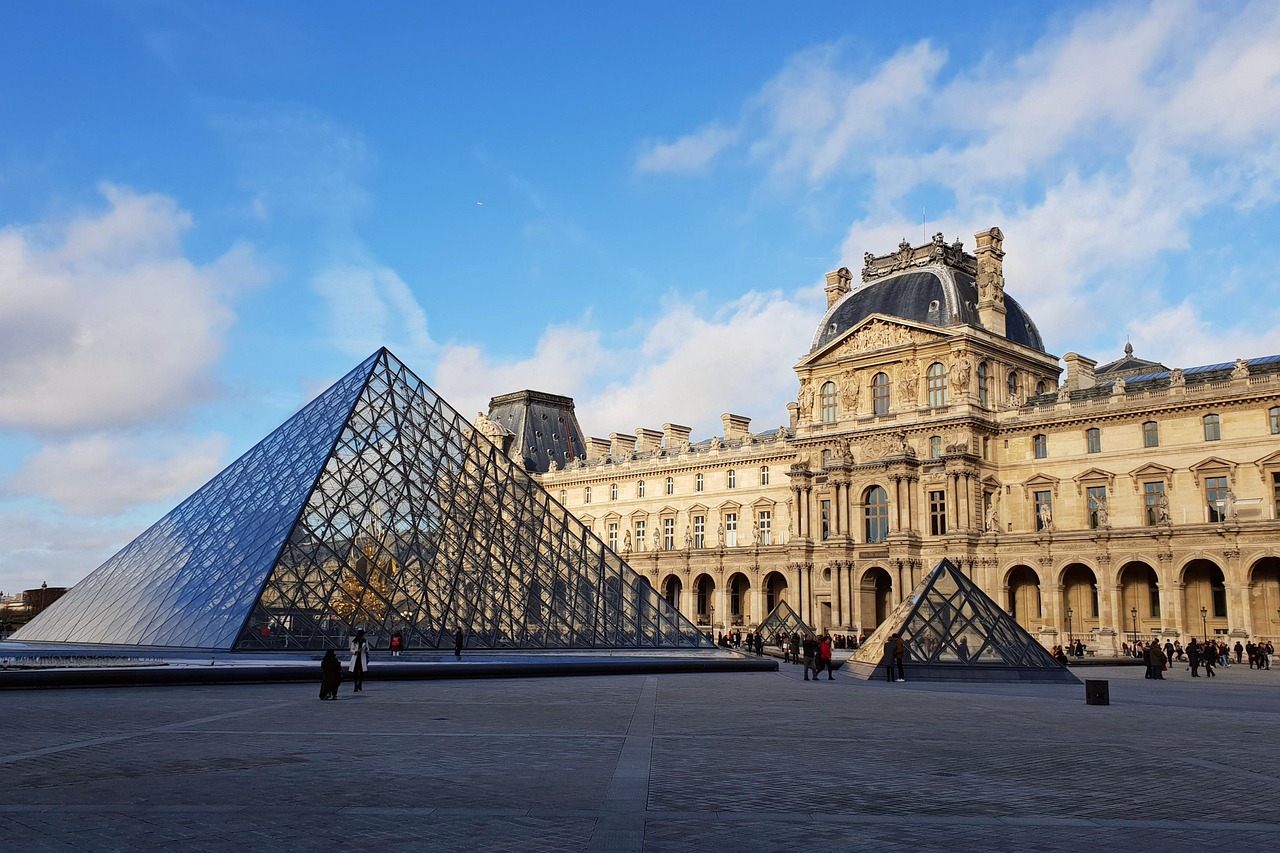
Finding the perfect place to see amazing art can be hard. The Louvre Museum in Paris is the world’s largest art museum. This blog will show you its rich history and stunning artworks.
Keep reading to discover more!
Key Takeaways
- The Louvre Museum started as a fortress in the 12th century and opened as a public museum during the French Revolution. Napoleon expanded its collections.
- It holds over 50,000 Egyptian pieces, Greek, Etruscan, and Roman art, Islamic artifacts, European sculptures, decorative arts, and famous Renaissance paintings including the Mona Lisa.
- The Grand Louvre Project modernized it with renovations like the glass pyramid entrance. There are interactive displays for visitors now.
- It faces controversies such as art looting by Napoleon and during World War II. Efforts are ongoing to return stolen artworks.
- Visitor tips include planning ahead to see must-see artworks like the Mona Lisa and using guides or apps for a better museum visit experience.
The Historical Evolution of the Louvre

The Louvre began as a fortress before transforming into a royal palace, and later opened its doors to become a public museum during the French Revolution. Napoleon’s reign further expanded the museum, and modern renovations continue to shape its identity today.
From Fortress to Royal Palace
Back in the 12th century, King Philip II built a fortress where the Louvre now stands. This place was meant to protect Paris from attacks. Later, in the 16th century, Francis I replaced it with a royal palace.
He loved art and wanted a beautiful home for his collection.
Over time, more kings added their touch. They made the palace bigger and filled it with art from all over Europe. By the time Louis XIV moved to Versailles, the Louvre was full of treasures.
Then it began its new life as a museum for everyone to enjoy.
The Revolutionary Opening as a Public Museum
The Louvre made a big change in 1793. It went from being a royal palace to a public museum. This was during the French Revolution. People wanted art for everyone, not just kings and queens.
So, they opened the museum’s doors to all.
First up were 537 paintings and sculptures. These were mostly taken from royals or church leaders. The idea was simple but powerful: share beauty and history with everyone, not just the rich.
Now came Napoleon’s time, bringing more art to the Louvre.
Napoleonic Era and Expansion
Soon after its grand opening as a public museum, the Louvre entered an era of great change under Napoleon Bonaparte. He was keen on making the museum a home for art from across Europe.
His armies brought back many pieces. These new additions included works from Italy and Egypt, among others.
Napoleon renamed it to Musée Napoléon in 1803. During his rule, the collection grew quickly. It reached over 5,000 pieces at one point. This made the Louvre an even bigger center for art and culture in Paris and beyond.
The Grand Louvre Project and Modern Renovations
The Grand Louvre Project was a major renovation of the museum that began in 1981 and concluded in 2003. The project aimed to modernize the facilities, expand exhibition spaces, and improve visitor accessibility.
It involved constructing the iconic glass pyramid entrance designed by architect I.M. Pei, which has become a symbol of the museum itself. The renovations also included updating climate control systems to better preserve the artworks and reorganizing galleries for a more cohesive visitor experience.
Following this extensive overhaul, the Louvre now offers enhanced amenities such as updated restrooms, elevators, and information desks to make visits more comfortable for travelers from around the world.
Additionally, technology integration allows for interactive displays and audio guides that enrich visitors’ understanding of the stunning art collections. These efforts have made exploring one of Paris’s most renowned cultural landmarks an even richer experience for tourists seeking to immerse themselves in art history.
Highlights of the Louvre’s Art Collections
The Louvre’s art collections include Egyptian antiquities, Greek, Etruscan, and Roman art, Islamic art, European sculptures and decorative arts, as well as Renaissance paintings like the Mona Lisa.
Notable for their historical significance and artistic mastery, these works form an exceptional cultural tapestry worth exploring further.
Egyptian Antiquities
The Louvre’s Egyptian Antiquities collection boasts over 50,000 pieces, including the iconic Great Sphinx of Tanis and the Seated Scribe from Saqqara. Spanning 4,000 years of history, it showcases artifacts like jewelry, sculptures, and mummies.
The most renowned exhibit is the Code of Hammurabi, a Babylonian law code dating back to 1754 BC.
This extensive collection houses items from various periods such as Old Kingdom mastabas and the New Kingdom tombs in Thebes. Visitors can explore captivating exhibits chronicling ancient Egyptian daily life as well as religious practices at their leisure.
These historic treasures provide an immersive look into one of the world’s oldest civilizations while exemplifying remarkable artistic achievements in architecture and sculpture.
Greek, Etruscan, and Roman Art
The Louvre houses an impressive collection of Greek, Etruscan, and Roman art. You can explore ancient sculptures, pottery, and jewelry from these civilizations. The museum’s curatorial departments meticulously preserve historical artifacts from these iconic cultures.
Visitors can marvel at intricate Roman mosaics and beautiful Greek statues like the Venus de Milo.
Greek, Etruscan, and Roman art pieces date back as far as 6th century BC. These priceless works offer a glimpse into the artistic achievements of these influential civilizations. The Louvre provides a fascinating window into the cultural heritage of ancient Greece and Rome through its outstanding collection of European masterpieces in this category.
Islamic Art
The Louvre’s Islamic Art collection includes exquisite artifacts from the 7th to the 19th century. It features ceramics, textiles, metalwork, and woodwork from various regions such as Spain, Egypt, Iran, and Turkey.
The museum’s impressive array of over 15,000 pieces showcases the technical mastery and artistic excellence of Islamic artisans throughout history. Notable highlights include the Ardabil Carpet from Iran dated around 1539-40 AD and intricately designed ceramic tiles from different periods.
Islamic artworks at the Louvre provide a glimpse into the diverse cultural influences that have shaped Islamic art over centuries. The collection demonstrates the intricate geometric patterns, calligraphy, and ornate designs that define this rich artistic tradition.
Visitors can witness how these masterpieces reflect historical and religious themes while showcasing exceptional craftsmanship.
European Sculptures and Decorative Arts
European Sculptures and Decorative Arts at the Louvre Museum showcase exquisite craftsmanship from the 15th to 19th centuries. You will find over 6,000 sculptures, including famous pieces like “Winged Victory of Samothrace” and “Venus de Milo”.
The decorative arts collection boasts stunning furniture, ceramics, and tapestries that offer a glimpse into European aristocratic life.
The art here spans across various movements such as Baroque, Rococo, and Neoclassicism. Visitors can marvel at intricate marble statues alongside delicate porcelain pieces. The attention to detail in these artworks reflects the opulence of European history.
These collections provide an enriching experience for anyone interested in exploring Europe’s artistic heritage while visiting the museum.
Renaissance Paintings, including the Mona Lisa
The Louvre Museum houses an exceptional collection of Renaissance paintings, featuring iconic artworks such as Leonardo da Vinci’s masterpiece, the Mona Lisa. This period’s art is known for its realistic portrayal of human emotions and perspectives.
Visitors can witness renowned pieces by Italian masters like Raphael, Caravaggio, and Titian, showcasing the artistic evolution during this era.
The Mona Lisa, painted by da Vinci in the early 16th century, remains a celebrated symbol of Renaissance artistry. Its enigmatic smile continues to captivate millions of visitors yearly.
The Louvre’s Renaissance paintings offer a captivating journey through history and provide profound insights into the cultural and artistic achievements of this time.
Continuing to Notable Satellite Museums and Partnerships…
Prints and Drawings
The Louvre Museum houses an extensive collection of prints and drawings, spanning from the Middle Ages to the mid-19th century. The Department of Prints and Drawings safeguards over 200,000 works on paper, including sketches by renowned artists like Leonardo da Vinci, Raphael, and Rembrandt.
Visitors can explore rare etchings, engravings, lithographs, and illustrated books that offer a unique insight into the development of visual arts throughout history. The diverse range of artistic techniques showcased in this department provides a valuable learning experience for art enthusiasts and scholars alike.
Notable Satellite Museums and Partnerships
The Louvre has expanded beyond its Parisian home, with notable satellite museums and partnerships. These include the Louvre-Lens in Northern France and the Louvre Abu Dhabi in the UAE.
Louvre-Lens in Northern France
The Louvre-Lens is a branch of the famous Paris museum. It’s located in Lens, Northern France and opened its doors in 2012. This satellite museum showcases art from the main collection.
The striking glass and aluminum structure was designed by architects Kazuyo Sejima and Ryue Nishizawa. Its aim is to bring art to areas outside Paris, offering a fresh perspective on historical masterpieces.
Louvre-Lens focuses on temporary exhibitions rather than housing a permanent collection. It also hosts cultural events and educational programs for visitors of all ages. One standout feature is the Galerie du Temps, where artworks are curated thematically across different periods, providing an engaging way to explore art history – quite distinct from the chronological display at the main Louvre site.
Louvre Abu Dhabi in the UAE
Transitioning from the Louvre-Lens in Northern France to the Louvre Abu Dhabi in the UAE, this satellite museum is a beacon of cultural exchange and collaboration. Established through an intergovernmental agreement between the United Arab Emirates and France, it opened its doors on November 8, 2017.
The museum’s architectural masterpiece was designed by Pritzker Prize-winning architect Jean Nouvel, featuring a stunning dome that weighs as much as the Eiffel Tower.
The Louvre Abu Dhabi showcases art and artifacts from diverse civilizations across various time periods. Its collection includes treasures such as an exquisite Ottoman helmet from Turkey dating back to the 16th century and Vincent Van Gogh’s self-portrait.
With over half of its items curated from ancient civilization pieces, visitors can explore humanity’s narrative through culture and creativity at this impressive institution.
Controversies in the Louvre’s History
Napoleon took many art pieces from other countries, causing controversies. During WWII, the Louvre faced issues with stolen artworks and had to work on returning them.
Napoleonic Looting of Art
During the Napoleonic era, from 1796 to 1815, Napoleon Bonaparte’s forces looted art and cultural treasures across Europe. Historical records show that around 5,000 paintings, sculptures, and other significant works of art were seized during this period.
Some of these stolen treasures ended up in the Louvre Museum and other French institutions.
The plundering of art by Napoleon’s armies had a widespread impact on countries across Europe. Many nations faced immense challenges in reclaiming their lost cultural heritage after the defeat of Napoleon.
The systematic looting during this time significantly depleted the artistic and historical wealth of several European countries, leaving a lasting impact on their cultural identities.
Nazi Looting and Restitution Efforts
The Louvre Museum was not immune to the Nazi looting of art during World War II. Numerous works were stolen from Jewish collectors and families, devastating their cultural heritage.
Although many pieces were recovered after the war, some remain unaccounted for. Efforts continue to this day to research and locate these missing artworks and return them to their rightful owners or descendants.
In recent years, the museum has been actively involved in provenance research, collaborating with international organizations such as the Commission for Art Recovery and the European Shoah Legacy Institute.
These efforts aim to identify looted art within its collections and facilitate restitution when possible. The Louvre also participates in initiatives like the Holocaust-Era Assets Conference to address historical injustices and uphold ethical standards regarding art restitution.
Visitor Tips for Exploring the Louvre
Maximize your visit by planning ahead, prioritizing must-see artworks, and using the museum’s resources for a smooth experience. Consider opting for guided tours to gain deeper insights into the collections and make navigating the vast museum more manageable.
Must-See Artworks and Galleries
When visiting the Louvre Museum, make sure to check out these must-see artworks and galleries:
- The Mona Lisa – Leonardo da Vinci’s iconic portrait, attracting millions of visitors annually.
- Winged Victory of Samothrace – A stunning Hellenistic sculpture depicting Nike, the Greek goddess of victory.
- Venus de Milo – An ancient Greek statue representing the goddess Aphrodite and admired for its graceful beauty.
- Napoleon III Apartments – Lavishly decorated rooms offering insight into French imperial life.
- Apollo Gallery – Known for its splendid ceiling painted by Charles Le Brun, showcasing richly adorned French Baroque art.
- Egyptian Antiquities Collection – Featuring artifacts like the Seated Scribe and the Great Sphinx of Tanis, providing a glimpse into ancient Egypt’s culture and history.
- The Grand Gallery – Home to incredible Italian Renaissance masterpieces, such as works by Raphael and Michelangelo.
- Islamic Art Collection – Displaying intricate ceramics, textiles, and metalwork from across the Islamic world, spanning over 1,300 years of artistic development.
- Department of Decorative Arts – Showcasing ornate furniture, precious tapestries, and exquisite objets d’art from various historical periods.
- Richelieu Wing Paintings – Housing celebrated European paintings including masterpieces by Rubens, Vermeer, and Rembrandt.
Navigating the Museum with Ease
Navigating the Louvre Museum with ease:
- Start your visit early to avoid long lines.
- Download the museum’s app for interactive maps and exhibit information.
- Consider a guided tour for an in-depth experience without getting lost.
- Pick up a museum floor plan upon entry to help you navigate the vast galleries.
- Focus on specific wings or exhibits to prevent museum fatigue.
Remember, comfortable shoes are a must for exploring the extensive galleries.
Special Exhibitions and Events
After exploring the Louvre with ease, visitors can also enjoy special exhibitions and events.
- Special Exhibitions: The museum hosts temporary exhibitions that showcase diverse themes, from ancient civilizations to modern art movements. These exhibits often feature rare treasures on loan from other institutions around the world.
- Evening Events: The Louvre offers special evening programs, allowing visitors to experience the museum after regular hours. These events may include live music performances, curated tours, or themed gatherings for an immersive cultural experience.
- Lecture Series: Engage in enriching discussions and talks led by art experts and historians. These lecture series delve into various aspects of art history and provide valuable insights into the museum’s collections.
- Family Workshops: The Louvre organizes interactive workshops designed for families, offering children and parents an opportunity to explore art together through crafts, storytelling, and hands-on activities.
- Film Screenings: The museum occasionally hosts film screenings related to art and culture, providing a unique way to appreciate visual storytelling alongside its renowned physical artworks.
- Collaborative Projects: Look out for collaborative projects with contemporary artists or other museums worldwide that bring fresh perspectives on historical collections through innovative artistic expressions.
- Holiday Celebrations: During festive seasons, the Louvre may organize thematic events or installations that celebrate cultural traditions, adding another layer of vibrancy to the museum visit.
Conclusion
In Paris, the Louvre Museum holds a rich history and impressive art collections. From its origins as a fortress to becoming a public museum, it has an intriguing evolution. Visitors can explore Egyptian antiquities, Renaissance paintings, and European sculptures among many other treasures.
The Louvre is not just a museum; it embodies cultural heritage and offers an enriching experience for all who visit.
FAQs
1. What is the Louvre Museum known for?
The Louvre Museum is famous for its rich history and vast art collections. It houses thousands of artworks, including the Mona Lisa and the Venus de Milo, showcasing pieces from different cultures and time periods.
2. How can I explore the art collections at the Louvre?
You can explore the art collections by visiting in person or taking virtual tours online. The museum offers guided tours that highlight key artworks, helping visitors appreciate their significance in history.
3. When was the Louvre Museum built?
Originally a fortress in 1190, it became a royal palace before opening as a public museum in 1793. Its long history adds to its charm, making each visit special.
4. Are there any special exhibits at the Louvre?
Yes! The Louvre often features temporary exhibits that focus on specific themes or artists. These exhibits provide fresh insights into various aspects of art history and keep visitors engaged with new experiences each time they visit.







Leave a Reply